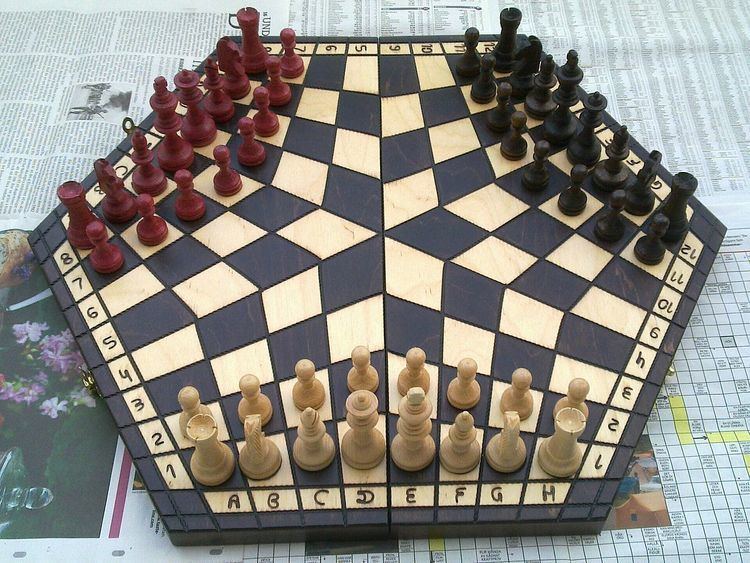 | ||
Three-player chess (also known as Three-handed, Three-man, or Three-way chess) is a family of chess variants specially designed for three players. Many variations of three-player chess have been devised. They usually use a non-standard board, for example, a hexagonal or three-sided board that connects the center cells (board "squares") in a special way. The three armies are differentiated usually by color.
Contents
- Hexagonal boards with quadrilateral cells
- Other boards with quadrilateral cells
- Boards with hexagonal cells
- Circular boards
- Using fairy pieces
- Boards with triangular cells
- Strategy
- References
Three-player chess variants (as well as other three-player games) are the hardest to design fairly, since the imbalance created when two players gang up against one is usually too great for the defending player to withstand. Some versions attempt to avoid this "petty diplomacy" problem by determining the victor as the player who first delivers checkmate (with the third player losing in addition to the checkmated player). Other solutions have been tried as well.
Another solution to the problem insurmountable imbalance in collusion in games with more than two players, but at the same time maintaining the possibility of cooperation - is the introduction of a special "neutrality rule", invented in 2006 Ilshat Tagiev:
The player whose turn it is to walk, can attack this enemy only if the enemy attacked his previous move it or if the opponent was not attacked by the third player on its previous course.
The term "attack" here refers to the capture of a figure or pawn opponent.
"The rule of neutrality" rules out, thus, the possibility of concerted serial attacks two players third. Since the role of walking is moving in a circle, each attacking move of each player limits the ability of attacking other players.
"The rule of neutrality" in games with more than 2 players significantly aligns balance brute force, while retaining the ability to multi-player cooperation mainly through the balance of the pieces on the game board.
We can formulate the "neutrality rule" thus:
"The one who in the previous round of moves for you was attacked by others, and he did not attack you, you can not attack."
Hexagonal boards with quadrilateral cells
Some variants use a special hexagonal board with quadrilateral cells (see example in the photo):
Other boards with quadrilateral cells
Some variants have used other board forms with quadrilateral cells:
Boards with hexagonal cells
Some variants use a board with hexagonal cells. Usually three bishops per side are included, to cover all cells of the hex playing field. Pieces move usually as in one of the versions of hexagonal chess:
Circular boards
Using fairy pieces
Some variants incorporate fairy chess pieces in addition to standard chess pieces.
Boards with triangular cells
An example of such a game - chess board in the form of a hexagon with a side of five triangles, which are patented in 2008 russian Ilshat Tagiev.
Unlike traditional chess room:
A special case of a pawn:
Total traditional chess room:
Strategy
The introduction of a third player drastically alters the style of play, even when standard pieces are used. Many chess openings are useless due to the extended board and third player. Each player must think twice as far ahead—anticipating the moves of both opponents, with the added complexity that the next player may move to attack either opponent.
If a player trades off pieces with a second player, the third player benefits. Hence, players will be more reluctant to make trades. Players often avoid such trades so as to carry out other strategies.
The introduction of the 'extra' move by the third player can introduce situations of deadlock, for example, if a white piece is undefended and simultaneously attacked by both black and red pieces. Black cannot take the white piece, since Red would then capture the black piece next turn. Thus the black and red pieces are both simultaneously attacking the white piece and defending it from attack by the other player. In similar situations, a piece can move quite safely to a square where it is attacked by both opponents, since neither opponent would take the piece and risk capture by the third player.
In games where the third player loses as well as the checkmated one, players must concentrate not only on their own attack and defense, but also on preventing the two opponents from checkmating one another. A player can take advantage of one opponent's position to checkmate the other, but must be careful that the third player does not checkmate first. White could checkmate Red, only to have his piece captured by a black piece, which checkmates Red. In this situation, White would lose since Black delivered the final checkmating move. This strategy also applies to games which give the checkmating player command of the checkmated opponent's pieces – a player who allows the second player to checkmate the third would surely go on to lose due to the increased power of his remaining opponent, now armed with the third player's pieces.
